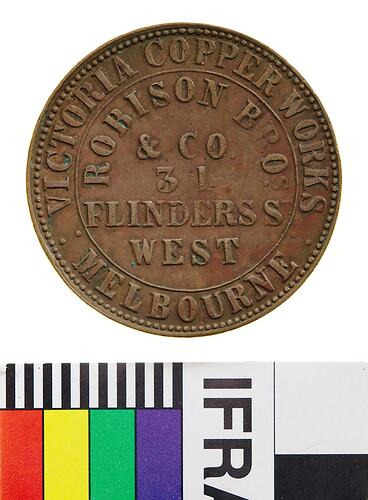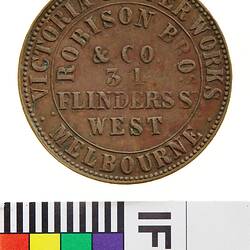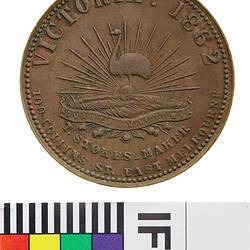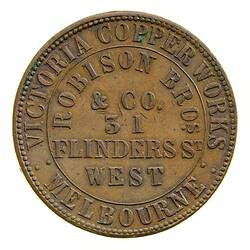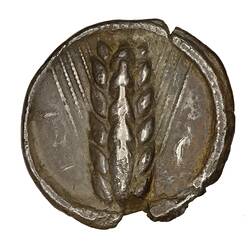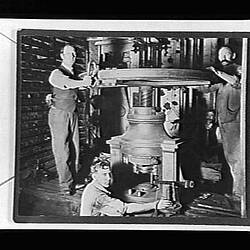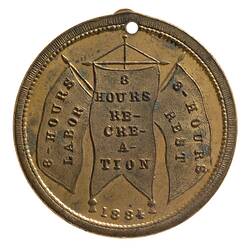Summary
Copper One Penny Token, minted by Thomas Stokes, Melbourne. Issued by Robison Bros.& Co, Victoria Copper Works, Melbourne, 1862. William and George Robison founded this company in 1854 and were joined by their brothers over the next nine years. In 1858 William Robison, one of the founders of the company, left to begin his own, competing business. By 1862 the main family firm was listed in Flinders Street, they later moved to South Melbourne. Once established in South Melbourne the business expanded, and in addition to their metal working business, Robison Bros. developed a substantial ships chandler's business. They remained at their South Melbourne site until 1971.
Previous Collections: George McArthur
Physical Description
A round copper token (34 mm diameter) featuring the name, company name and address of the issues: Robison Brothers, Victoria Copper Works, 31 Flinders Street West, Melbourne The reverse features an emu standing facing left in front of a rising sun with fifteen long light rays. Below on a scroll the motto ADVANCE VICTORIA with a spread bouquet of rose thistle and shamrock emerging below scroll. Around above, VICTORIA . 1862, around below in two lines, T. STOKES _ MAKER / 100 COLLINS ST. EAST MELBOURNE. Border of 122 beads, the head of the emu is between the 7th and 8th ray. It is numbered in the standard catalogues as: Sharples Emu 2 = Heyde Emu 4 = Andrews 20.
Obverse Description
At centre within line circle, ROBISON BROS. / & CO. / 31 / FLINDERS ST / WEST; around, VICTORIA COPPER WORKS : MELBOURNE : (Sharples' obverse C). The DE of FLINDERS is weakly struck.
Reverse Description
At centre an emu standing facing left in front of a rising sun with fifteen long light rays. Below on a scroll the motto ADVANCE VICTORIA with a spread bouquet of rose thistle and shamrock emerging below scroll. Around above, VICTORIA . 1862, around below in two lines, T. STOKES _ MAKER / 100 COLLINS ST. EAST MELBOURNE. Border of 122 beads, the head of the emu is between the 7th and 8th ray. This reverse die is numbered in the standard catalogues as: Sharples Emu 2 = Heyde Emu 4 = Andrews 20.
Edge Description
Plain
More Information
-
Collection Names
-
Collecting Areas
-
Acquisition Information
Transfer from National Gallery of Victoria (NGV), George McArthur, 15 Mar 1976
-
Date Issued
1862 AD
-
Issued By
Robison Bros.& Co Victoria Copper Works, Melbourne, Greater Melbourne, Victoria, Australia, 1862
-
Mint
Stokes (Mint), Melbourne, Greater Melbourne, Victoria, Australia, 1862
-
Previous Collection
-
Inscriptions
Obverse: ROBISON BROS. & CO. 31 FLINDERS ST WEST VICTORIA COPPER WORKS MELBOURNE Reverse: VICTORIA . 1862 T. STOKES MAKER. 100 COLLINS ST EAST MELBOURNE
-
Denomination
-
Series
-
Material
Copper
-
Axis
06
-
Classification
-
Category
-
Discipline
-
Type of item
-
Dimensions
34 mm (Outside Diameter), 15.99 g (Weight)
-
Shape
Round
-
References
The issue of tokens for Robison Brother & Co. Victoria Copper Works required three different obverse dies. These can be quickly identified by the following steps: 1. If there is a dot under the letter T of ST (of FLINDERS ST) it is from obverse A. 2. If there is no dot under the letter T of ST and the letter S of BROS is below the letters RK of WORKS it is obverse B 3. If there is no dot under the letter T of ST and the letter S of BROS is below the letters K of WORKS it is obverse C. The reverse were Stokes stock dies with the following combinations observed: Obverse A combined with Arms 1 and Emu 4 Obverse B combined with Emu 1 Obverse C combined with Emu 1, Emu 2 (this token) and Vine 1 During this work Stokes acquired their own copper rolling mill permitting them to manufacture their own blanks. It is thought that the commercially available copper sheets were too thin and caused the dies to break. When they were able to prepare thicker blanks this was overcome. The weights of the tokens reflect the thickness of the blanks they were struck on. See Sharples JNAA.7 p55 - 56. Possible linkages between Stokes and the Victoria Copper Works in respect of blank production might prove useful.
[Thesis] Lugton, Mary E. 1989. George McArthur of Maldon: his Life and his Book Collection.
[Catalogue] Morrison, Ian. 2003. The Baker of Maldon.
[Book] Andrews, Arthur. 1921. Australasian Tokens and Coins., No. 462
[Book] Heyde, Gilbert C. & Skinner, Dion H. 1967. Unofficial Coins of Colonial Australia and New Zealand., No. 218/1
[Article] Sharples, John P. 1993. A Catalogue of the Trade Tokens of Victoria 1848 to 1862. Journal of the Numismatic Association of Australia. vol.7: p.1-77., V. 129
-
Keywords
